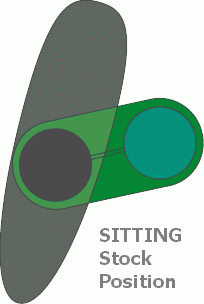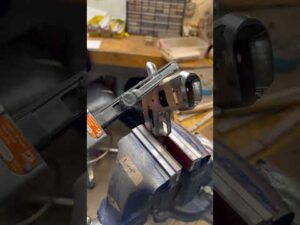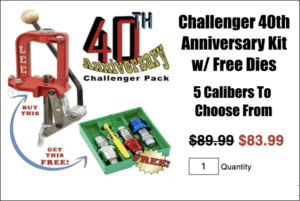May 14th 2023Sunday gunday: Tubb2000 Rifle in 22,BR with 90gr bulletsMany consider the 22BR cartridge to be a varmint cartridge. With modern bullets with high BC, it can perform well at long ranges. The 22BR is a versatile rifle that excels in a wide range of shooting disciplines. It uses high-BC 80-95gr bullets. Clint Greenwood’s Tubb 2000 rifle is featured here. Clint tested the Sierras against the 90gr JLKs (Jimmy Knox). The new Sierras are expected to match the performance of the JLKs using readily-available factory ammunition. It’s good news for those who shoot long ranges, as we’ve heard Jimmy Knox is retiring from bullet manufacturing.Clint Greenwood, a Texan, told us about a 22BR project he was working on a few seasons ago. We were intrigued by the possibility of 90gr Bullets in this cartridge. Clint says: “I became interested in the 22BR after working on its parent case, 6mm BR Norma. I became interested in 6BR around three years ago. I read everything I could about the 6BR. Especially several of Larry Bartholome’s Precision Shooting articles. I was convinced I needed a 6BR so I sent a Rem 700 short-action that I owned to Greg Tannel to do some work. While I waited for the rifle’s return, I gave in to the fever and bought a Tubb2000, also in 6BR. Both rifles were excellent. It was much harder to find a 6BR load that didn’t perform well than one that did. I spend most of my time shooting High Power XC but also shoot the occasional prone matches. My home club was building a 1000-yard shooting range and would soon begin monthly 1000 prone match. I had originally planned on shooting one of my 6BRs, but a friend who shoots with me, a 6BR enthusiast, had recently constructed a bolt-gun made in 22BR and was very pleased with it. We talked for a long time about his rifle. Dave Kiff had a reamer made that allowed him to neck down Lapua brass to 22 BR without having to neck turn. His rifle was barreled using a 7.7 twist Kreiger and he was shooting the 80 Sierra MK with great success.
I am primarily an AR shooter who is a Service Rifle. Knowing that I was limited by the AR Service Rifle at long distance, I always tried to get the best advantage. When the.224-90gr Jimmy Knox VLDs were released… I jumped in with a passion. I was able to get 2750 FPS out of the.223 case with the 90 using VV N540 primers, moly and the CCI 450 primers. This familiarity with the quirks and peculiarities of the 90 JLK led to me building a prone rifle for my wife in.223.I asked John Holliger to chamber a 30? PacNor 1:6.5?-twist was chambered for the rifle. John Holliger, who pioneered 6.5-twists, is the absolute guru of 6.5-twists. John Holliger has made a half dozen 6.5-twist PacNors for me, and they have all been a hummer. The 30? I was able push the 90gr JLK at 2900 FPS using the 30? The BC of the 90gr JLK has been listed between.560 and.590. When I pushed it at 2900 FPS, it was clear that the 90gr JLK, for a.22, was the best bullet to deal with wind. [Editor’s Note: There are other high-BC bullets in.22 caliber from Berger Lapua and Sierra.] Several factors came together at once to turn on the dim 10-watt light bulb inside my head. I had a lot of Lapua 6BR Brass, several thousand 90gr. JLKs, and a friend who was willing to lend me a 22BR Reamer. I also had a gunsmith who knew his way around 6.5-twist PacNor barrels. I was doomed. Holliger chambered 30? I used my friend’s reamer to ream a 6.5-twist PacNor into my T2K. I was busy preparing my tooling. When the barrel arrived, i removed the 6BR barrel from my T2K and screwed on the 22BR barrel. “22BR Cartridge BasicsThe simple wildcat 22BR cartridge is formed by necking down 6mm BR brass. Case forming is simple — just run a 6-BR case through a die for 22BR. The 22BR has performed well in NBRSA Benchrest short-range shooting with custom bullets. The accuracy of the 6mm BR is comparable to the 22BR up to 250 yards. However, 6mm VLDs with their high BCs are better at bucking the wind. Forming the 22BR caseForming 22BR Brass is not difficult. Start with 6mm BR case from Peterson or Lapua and run it through a full-length 22BR sizing die. To reduce run-out, rotate the case a half turn half-way through. Finish by running the case up to the FL die. You can also use a bushing-neck-sizing die. However, it will go more smoothly if an intermediate bushing is used, followed by a second pass using the final bushing. If you have the Redding 22BR die and want to use it first, this will reduce the neck so that you can finish with just one bushing. The full-length sizing tool is better, as bushings can push brass to the neck-shoulder intersection (NSJ). We suggest that you use either method, but we recommend that you run a mandrel along the necks and then neck-turn the final.050? You can neck-turn the last.050? This will help prevent doughnut formation and remove any bulges at the NSJ. Remember to load a few dummy cartridges before you specify the neck diameter of your reamer. This will ensure that your cases will chamber properly without neck-turning.
Clint used the K&M Neck Turner to remove the doughnuts that were formed after necking the brass down from 6mmBR. He then ran the brass through the sizer with no expander and inside-neck-reamed it with a.221-reamer. He used a mandrel as a final step to expand the necks. He used two different mandrels in order to get some cases with.004 neck tension and others with.002 necktension. Clint reported: I talked with Wes Grass who had been experimenting with the 22BR, and the 90-grain JLK. He said that Varget was a great powder for the 6BR but too fast to push the 90-grain with the 22BR. Wes suggested that I try VV N550. I had some on hand. I loaded incremental loads 0.5 graina Varget and N550 in two different sets neck-tensioned cases. After speaking with Wes and learning about his Varget loads, I started the Varget loads with 30.0 and went up to 32.0. The N550 also started at 30.0 and went up to 31.5″ Here is a table with the loads Clint worked up using the 90gr JLK:VARGET ChargeVelocityExtreme SpreadStd. Dev.30.5302214.36.231.030912811.532.0 Ejector marks — too hot31852.52.2Vihtavuori N550 ChargeVelocityExtreme SpreadStd. Dev.30.0286160.92730.529304616.531.029603312.731.3 — Match Load305022931.5306210.54.9Clint noted: “All of the above loads used Lapua 6BR brass, neck turned and reamed, .004 tension, CCI BR4 primers. I settled on.003 neck tightening. These loads worked well in my rifle. Reduce them by at least 10%! [EDITOR’S NOTE] If you start around 10% under these loads, then that should be an excellent starting point for using the Sierra Match-King 90gr in a 22BR. Final Thoughts about Bullets, Powder, and the 22BR
Clint Greenwood discovered that his 90gr JLK Caliber.22 Caliber worked the best in his barrel when seated well into his lands. You may have different results if you use different hybrid or VLD bullets. Clinet explained how he developed his load using 500 series powder. He noted that he needed to raise the pressures pretty high. “The groups will shrink dramatically with higher pressures.” As soon as you reach the operating pressue for the 500-series powder, the groups will shrink dramatically. It’s like a switch being thrown. “The components I chose didn’t surprise me when I was preparing loads for the 22BR. The VV N550 loads started to group at 30.5 grams. The 31.5 grains of N550 produced some impressive groups and chrono numbers. I decided to reduce the weight by 0.2 grains as I could be shooting these loads in temperatures ranging from 45 to 110 degrees. The VV 500 Series is not temperature sensitive, it’s not as good as Varget but still decent. However, I had experienced some “pressure excursions” in.223, which were unsettling. I didn’t want that to happen with my T2K. Dropping the loads by 0.2 grains did not seem to affect accuracy, and I was able to get a little extra insurance. The warmer N550 loads consistently stayed under 1/2 MOA at 200 yards. I’m expecting a little better results if I use the brass that has been fireformed instead of the Lapua newer loads with.010? runout. I am very pleased with my T2K accuracy in 22BR. John Holliger deserves the most credit. All of this wouldn’t have been possible if he hadn’t taken a risk and experimented using the PacNor 6.5-twist.22 barrel. Good luck, and remember to build up to these loads. Clint Greenwood David Tubb explains T2K stock adjustments I recommend setting the stock length a bit longer than most people would. I believe it is better to “reach” a little for the pistol grip, as this will ensure a secure and strong hold on the rifle. I pull my rifle firmly into the shoulder pocket when I shoot offhand. I also like to have a very firm contact between the rifle butt and the shoulder in both the prone and sitting positions. When using a shoulder sling, the stock length and sling tension should be sufficient to allow you to at least push the buttpad with your hand to place the stock in the pocket. My buttstock is the shortest offhand, and the longest prone. If I set my standing setting to “0”, then I am usually about 1-1/2″ out for sitting, and another inch or so for prone. I’ve found that many people shoot with stocks that are too long when sitting and too short anywhere else. The cast off/on feature on the buttstock has helped me achieve the natural shooting positions that I want. For prone I offset the clamping blocks so that the buttplate moves forward [the index mark is to the left of the center on the scale in the receiver extension tube]. I swing it slightly inwards for offhand, and slightly more inwards for sitting. The amounts of cast-on/off (in terms of clock-face) are approximately 8:00 for sitting, 4:30 for standing and 6:30 for prone. Stock Position Diagrams Copyright 2004 Glen Zediker David Tubb and Superior Shooting Systems Inc. Used with permission. Stock Length Adjustment Procedure
The length of the buttstock can be adjusted by 4 inches or more. After loosening the clamping block’s four screws, you can adjust the length of the buttplate by moving it in or out. The buttstock tube must be fully contained within the block. The amount of rearward movement (lengthening), is determined by how flush the front of buttstock tube fits with the front block. Cast and Cant Adjustment Method
By loosening four screws on the clamping blocks and rotating the block on receiver extension tubes, the buttstock can be adjusted for cast or offset. The buttplate is adjustable up to 360 degrees for cant. After loosening the screw in the center of rubber recoil pad, the height is adjustable at approximately 1-1/2 inch. The cheekpiece can be adjusted vertically by approximately one inch. The top knurled circle is used to adjust the vertical cheekpiece. The lower knurled setting will be secured by the lower knurled setting. Superior Shooting Systems can provide more information about the Tubb 2000 Rifle, SSS Accessories and other SSS products.
Tubb 2000 Accessories is a manufacturer of Tubb 2000 Accessories.
Bullets and Brass from DTAC
DavidTubb.com top photo, home page and stock position diagrams are all copyright (C), 2010, Glen Zediker and David Tubb. Used with permission. All Rights Reserved. Other content Copyright (C), 2023 AccurateShooter.com. All Rights Reserved. No reproduction without written permission.
Similar Posts

















